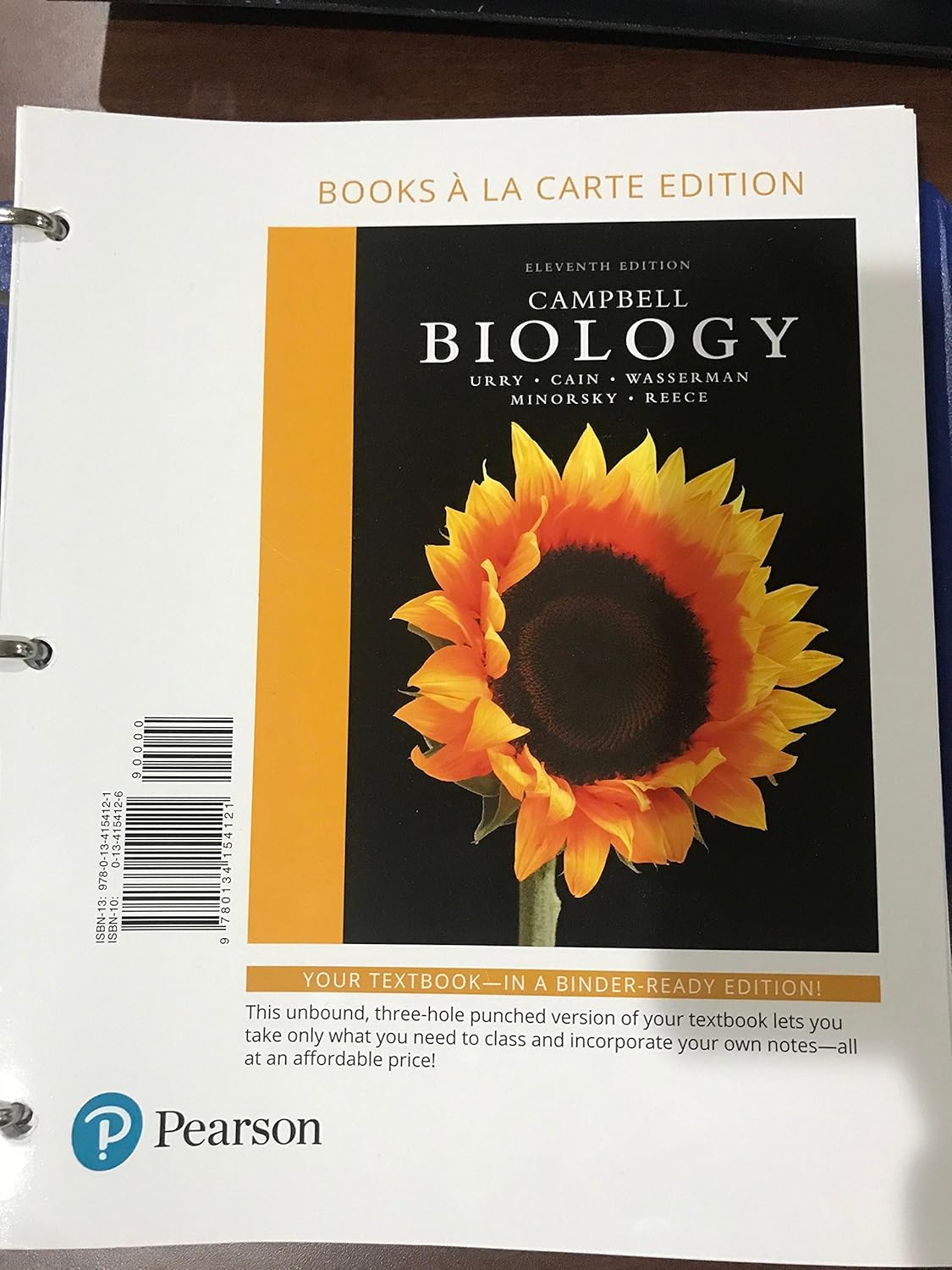About this deal
The 11th Edition of the best-selling Campbell BIOLOGY sets students on the path to success in biology through its clear and engaging narrative, superior skills instruction, innovative use of art and photos, and fully integrated media resources to enhance teaching and learning. Make Connections Questions ask students to relate content in a chapter to material presented earlier in the course to help them see the connections between different areas of biology, from molecules to organisms to ecosystems. Concept 15.1 Morgan showed that Mendelian inheritance has its physical basis in the behavior of chromosomes: scientific inquiry
Concept 23.3 Natural selection, genetic drift, and gene flow can alter allele frequencies in a population The third chapter, “Water and Life,” provides a more detailed examination of the properties of water and its role in biological systems. Students learn about the different types of chemical bonds that hold water molecules together, as well as the different properties of water that make it essential for life, such as its ability to dissolve and transport nutrients. Concept 10.3 After pyruvate is oxidized, the citric acid cycle completes the energy-yielding oxidation of organic molecules
Wikipedia citation
Selected figures now include Figure Legend Questions that encourage students to delve into complex diagrams and assess their understanding of the underlying concepts. Until those free-source online textbooks gain user-friendliness and traction against the capitalist beast that is the textbook system, it will remain ubiquitous. (And boy, is that rant about the abuses of the textbook business long, off-topic, and totally for another day.)
Concept 36.1 Adaptations for acquiring resources were key steps in the evolution of vascular plants Active Learning and Assessment: Campbell BIOLOGY, Eleventh Edition, provides students with multiple opportunities to deepen their understanding of biology: Many Tutorials and Activities in MasteringBiology integrate art from the text, providing a unified learning experience. The first chapter of the section, “Introduction: Evolution and the Foundations of Biology,” provides an overview of the basic principles of biology and the different levels of organization that exist within living organisms. Students learn about the principles of evolution and natural selection, as well as the different fields of biology that exist, such as ecology, genetics, and molecular biology. Neil Campbell combined the investigative nature of a research scientist with the soul of an experienced and caring teacher. He earned his M.A. in Zoology from UCLA and his Ph.D. in Plant Biology from the University of California, Riverside, where he received the Distinguished Alumnus Award in 2001. Neil published numerous research articles on desert and coastal plants and how the sensitive plant ( Mimosa) and other legumes move their leaves. His 30 years of teaching in diverse environments included general biology courses at Cornell University, Pomona College, and San Bernardino Valley College, where he received the college’s first Outstanding Professor Award in 1986. Neil was a visiting scholar in the Department of Botany and Plant Sciences at the University of California, Riverside. In addition to his authorship of this book, he coauthored Biology: Concepts & Connections and Essential Biology with Jane Reece.For the Ninth Edition of this book, we honor Neil’s contributions to biology education by adopting the title Campbell BIOLOGY.Concept 28.2 Excavates include protists with modified mitochondria and protists with unique flagella The Test Your Understanding Questions are organized into three levels based on Bloom’s Taxonomy: Knowledge/Comprehension, Application/Analysis, and Synthesis/Evaluation. Question types include Visual Skills: Draw It, Scientific Inquiry, Evolution Connection, Write About a Theme (Organization, Information, Energy and Matter, or Interactions), and Synthesize Your Knowledge. The impact of genomics and gene editing across biology is explored throughout the Eleventh Edition. Examples show students how our ability to sequence DNA and proteins rapidly and inexpensively is transforming every subfield of biology, from cell biology to physiology to ecology. Concept 45.2 Fertilization depends on mechanisms that bring together sperm and eggs of the same species Concept 9.3 Transduction: Cascades of molecular interactions relay signals from receptors to target molecules in the cell
Concept 7.6 The cytoskeleton is a network of fibers that organizes structures and activities in the cell Concept 53.3 The logistic model describes how a population grows more slowly as it nears its carrying capacityInterpret the Data questions throughout the text ask students to analyze quantitative information presented in a graph or table. These questions can be assigned in Mastering Biology. Make Connections Questions ask students to relate content in a chapter to material presented earlier in the course to help them see how the different areas of biology are connected, from molecules to organisms to ecosystems. Make connections to the overarching theme of evolution in every chapter with new Evolution sections Concept 10.4 During oxidative phosphorylation, chemiosmosis couples electron transport to ATP synthesis I'm not one to review textbooks used for school on Goodreads, but this one is good enough for me to make an exception.
Concept 51.5 Ecological change and evolution affect one another over long and short periods of time Concept 43.2 Coordinated cycles of heart contraction drive double circulation in mammals Concept 43.3 Patterns of blood pressure and flow reflect the structure and arrangement of blood vessels Professorship and serves as Chair of the Biology Department. She has published research articles on various topics involving Concept 52.4 Genetic analyses and the concept of inclusive fitness provide a basis for studying the evolution of behaviorConcept 8.3 Passive transport is diffusion of a substance across a membrane with no energy investment Concept 19.1 DNA sequencing and DNA cloning are valuable tools for genetic engineering and biological inquiry Every chapter now includes at least one Inquiry figure that helps students understand the experimental basis of biological knowledge and model scientific thinking. Each Inquiry figure now references the Source of the article, encouraging students to extend their learning by exploring the primary literature. Selected Inquiry Figures direct students to read and analyze the original article in a new Inquiry in Action: Interpreting Scientific Papers supplement to the text.
Related:
 Great Deal
Great Deal 